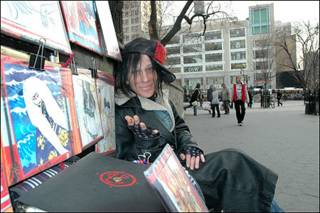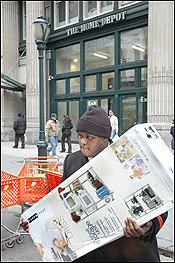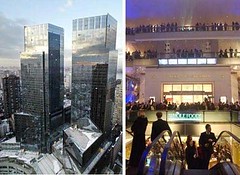National Retail Chains Take Manhattan

Zane Fix displayed his paintings, which he calls punk Japanese, in Union Square Park. A DSW shoe store is one of several retail chain stores facing the park. (Boston Globe Photo / Joe Tabacca)
 In "For New Yorkers, a case of little town blues: As once-suburban retailers move in, locals miss the grit", the Boston Globe reports on how national retail chains are an increasingly dominant presence in Manhattan (it's also happening in Brooklyn).
In "For New Yorkers, a case of little town blues: As once-suburban retailers move in, locals miss the grit", the Boston Globe reports on how national retail chains are an increasingly dominant presence in Manhattan (it's also happening in Brooklyn).Tatsha Robertson writes "Union Square Park is where young people with purple hair hang out, daring skaters soar off concrete steps, and protesters, poets, and the homeless converge most evenings. There, artist Zane Fix, who was selling his ''punk Japanese' paintings the other night, seemed in perfect harmony with the bohemian set. Step outside the historic park in lower Manhattan, though, and the edgy scene disappears into commercial conformity on 14th Street. Where family-run delis and five-and-dime stores stood, retail chains like Whole Foods Market, Barnes & Noble, and Filene's Basement proliferate. A few miles uptown, dapper doormen stand before one of two new Home Depot stores in Manhattan, as others do outside a Bed Bath & Beyond that recently opened near Lincoln Center.
 Jared Baptist, doorman for Home Depot on Manhattan's 23d Street, carried a box to a customer's car. (Globe Photo / Joe Tabacca)
Jared Baptist, doorman for Home Depot on Manhattan's 23d Street, carried a box to a customer's car. (Globe Photo / Joe Tabacca) Photo from the Gothamist. "Over at Columbus Circle, where Midtown meets the Upper West Side, a new mall has attracted thousands of shoppers since opening last year. 'On 14th Street, it was all five and dimes. Now it's all commercial. It's just changed. I am not sure if it changed for the better,' Fix said. ''It's as suburbanized as a metropolitan area can be.' To a born-and-bred New Yorker like Fix, 47, the nation's largest city is losing its distinctive grittiness. Spurred by the city's frantic real estate market, which has converted Manhattan neighborhoods once plagued by crack into prime property, and pumped by an aggressive cleanup that started a decade ago, this squeakier-clean Manhattan is filled with luxury condos, Starbucks franchises, and a growing number of superstores. The change has made some New Yorkers yearn for the old days."
Photo from the Gothamist. "Over at Columbus Circle, where Midtown meets the Upper West Side, a new mall has attracted thousands of shoppers since opening last year. 'On 14th Street, it was all five and dimes. Now it's all commercial. It's just changed. I am not sure if it changed for the better,' Fix said. ''It's as suburbanized as a metropolitan area can be.' To a born-and-bred New Yorker like Fix, 47, the nation's largest city is losing its distinctive grittiness. Spurred by the city's frantic real estate market, which has converted Manhattan neighborhoods once plagued by crack into prime property, and pumped by an aggressive cleanup that started a decade ago, this squeakier-clean Manhattan is filled with luxury condos, Starbucks franchises, and a growing number of superstores. The change has made some New Yorkers yearn for the old days."_____
What makes vibrant cities so exciting is the life on the street. Malls subtract from the street. Chains can add variety, but have a downside as their ability to pay higher rents makes chains more attractive to developers (especially those that operate on national and international scales, where they negotiate master arrangements that cover dozens or even hundreds of locations). This prices out the diversity that independent operators would normally bring to such a vibrant location as Union Square.
 Holiday Market at Union Square (it runs from Thanksgiving to Christmas from 11 am to 8 pm every day). Photo from Project for Public Spaces. This photo is a little more pristine and way less crowded than the scene I remember from this past December. But I bought a bunch of unique stuff and it seemed a lot more interesting than many of the big chains that now surround the Square. (Although I did like Barnes and Noble and the book department of the Virgin Megastore.) See this blog entry about "street level" Union Square. And this is a moving photo panorama of the Union Square Greenmarket.
Holiday Market at Union Square (it runs from Thanksgiving to Christmas from 11 am to 8 pm every day). Photo from Project for Public Spaces. This photo is a little more pristine and way less crowded than the scene I remember from this past December. But I bought a bunch of unique stuff and it seemed a lot more interesting than many of the big chains that now surround the Square. (Although I did like Barnes and Noble and the book department of the Virgin Megastore.) See this blog entry about "street level" Union Square. And this is a moving photo panorama of the Union Square Greenmarket.



0 Comments:
Post a Comment
<< Home